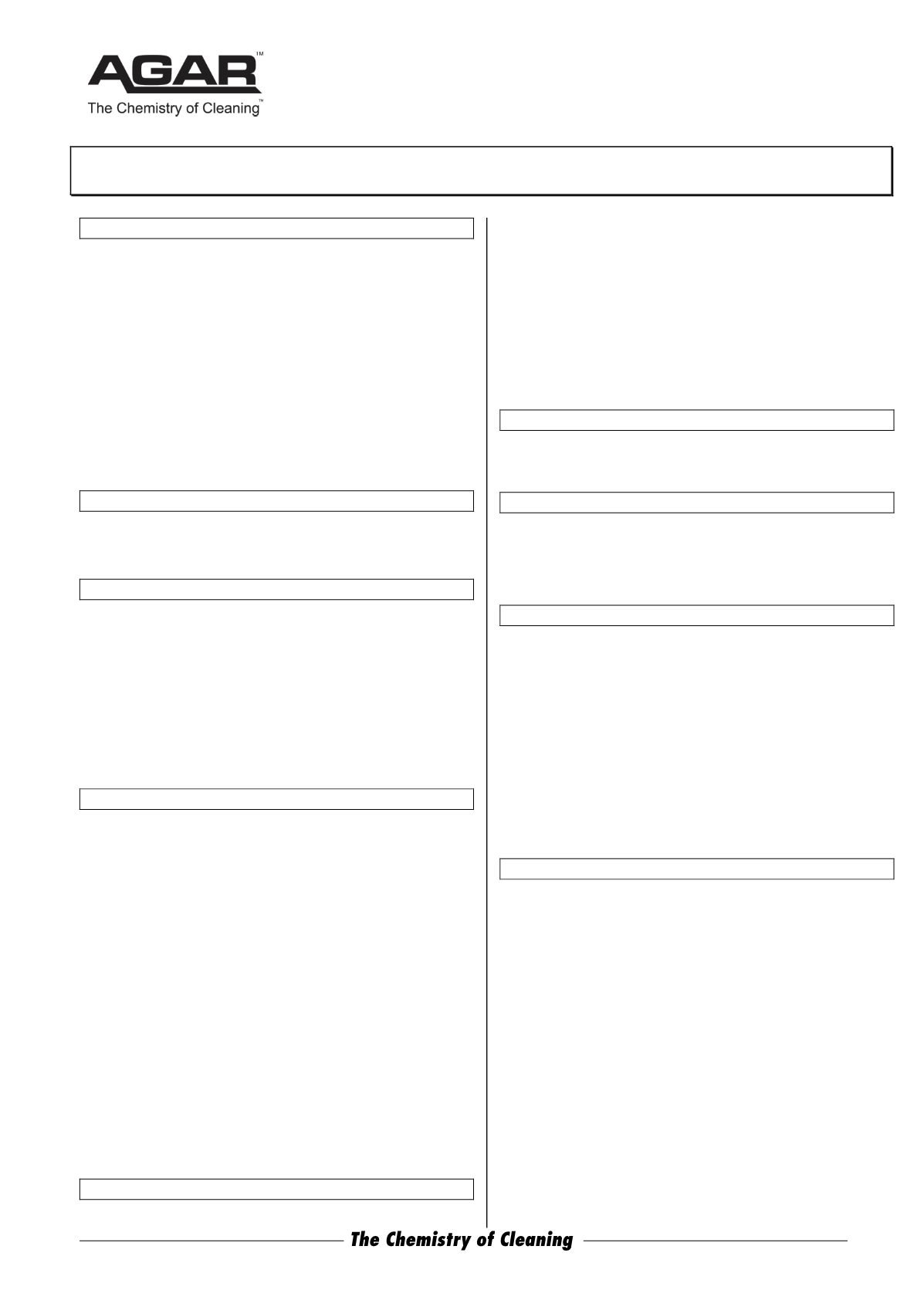

ABN 80 004 726 890 | MADE IN AUSTRALIA
VIC 03 9480 3000
NSW 02 9743 6020
SA 08 8293 2020
QLD 07 3274 3438
WA 08 9249 4566
Safety Data Sheet
Issued: January 12, 2016
Page 1 of 2
ORCHIDS
1 IDENTIFICATION OF THE MATERIAL AND SUPPLIER
Product Name:
ORCHIDS ANTIBACTERIAL DETERGENT
Other Names: None
Manufacturer's Product Code: ORC5, ORC20
Product Use: Hard surface cleaning, sanitising and deodorising.
SUPPLIER DETAILS
Company: Agar Cleaning Systems Pty. Ltd.
Address: 12-14 Cope Street, Preston, Vic. 3072
Telephone: 03 9480 3000 Facsimile: 03 9480 5100
Web:
www.agar.com.auAgar SDS are available from this website.
E-mail:
admin@agar.com.auEmergency Telephone Number: 131 126
(Aust wide)
2 HAZARDS IDENTIFICATION
Not classified as hazardous according to criteria of Safe
Work Australia. Not classed as Dangerous Goods.
3 COMPOSITION / INFORMATION ON INGREDIENTS
Ingredients:
Chemical Entity:
CAS No.: Proportion:
Quaternary ammonium compounds 63449-41-2 < 10%
Surfactants
non-haz < 10%
Perfume
-
< 10%
Colour dyes
-
< 10%
Water and 7732-18-5
other non-hazardous ingredients to 100%
4 FIRST AID MEASURES
Poisons Information Centre: Phone 131 126
Swallowed:
If poisoning occurs, contact a doctor or Poisons
Information Centre. If swallowed, do NOT induce vomiting.
Give two glasses of water and seek medical help. Rinse
mouth with water. Never give anything by mouth to an
unconscious person.
Eye:
Immediately hold the eyes open and wash continuously
for at least 10 minutes with fresh running water. Ensure
irrigation under eyelids by occasionally lifting the upper and
lower lids. Seek medical advice. Removal of contact lenses
after an eye injury should only be undertaken by skilled
personnel.
Skin:
Remove any contaminated clothing and flush area with
water. Wash the skin thoroughly with soap and water. Seek
medical attention in the event of irritation.
Inhaled:
Remove from the source of vapour, spray or fumes.
Remove patient to open space or fresh air, rest patient, keep
warm and seek medical advice. Give artificial respiration if
breathing stops.
5 FIRE FIGHTING MEASURES
Fire/Explosion Hazard: Orchids is not combustible.
Fire Extinguishing media: Water spray or fog. Foam. Dry
chemical powder. Carbon dioxide.
Fire Fighting PPE: Wear breathing apparatus and protective
clothing.
Special fire-fighting procedures: None.
Unusual fire hazards: None.
Hazardous products of combustion: Thermal decomposition at
temperatures above 200 deg C or in a large fire may yield
toxic fumes which my cause severe eye, nose, throat and lung
irritation. Use adequate ventilation.
6 ACCIDENTAL RELEASE MEASURES
Clean up all spills immediately. Spills may be slippery. Avoid
contact with skin and eyes. Contain spill and mop up.
7 HANDLING AND STORAGE
Storage and Transport: Store in a cool, dry place.
Incompatibility (Materials to avoid for purposes of transport,
handling and storage only): None.
8 EXPOSURE CONTROLS / PERSONAL PROTECTION
Exposure Standards: None assigned for this mixture or
ingredients.
Engineering Controls: Mechanical ventilation: Not required
under normal conditions.
Personal Protection:
Gloves - Wear rubber gloves if prolonged skin contact is
anticipated.
Eye-protection - Safety glasses required if splashing is likely.
Respiratory – Not nnormally eeded.
9 PHYSICAL AND CHEMICAL PROPERTIES
Appearance: Brown liquid
Odour: Floral fragrance
pH = 9.5 ± 0.5
Vapour Pressure: N/K
Vapour Density: N/K
Boiling Point: 100
°
C
Freezing Point: < 0
°
C
Solubility in water: Infinitely miscible
Specific Gravity : 1
Evaporation rate: As water
% Volatile by vol: <2% VOC
Please turn to page 2.


















